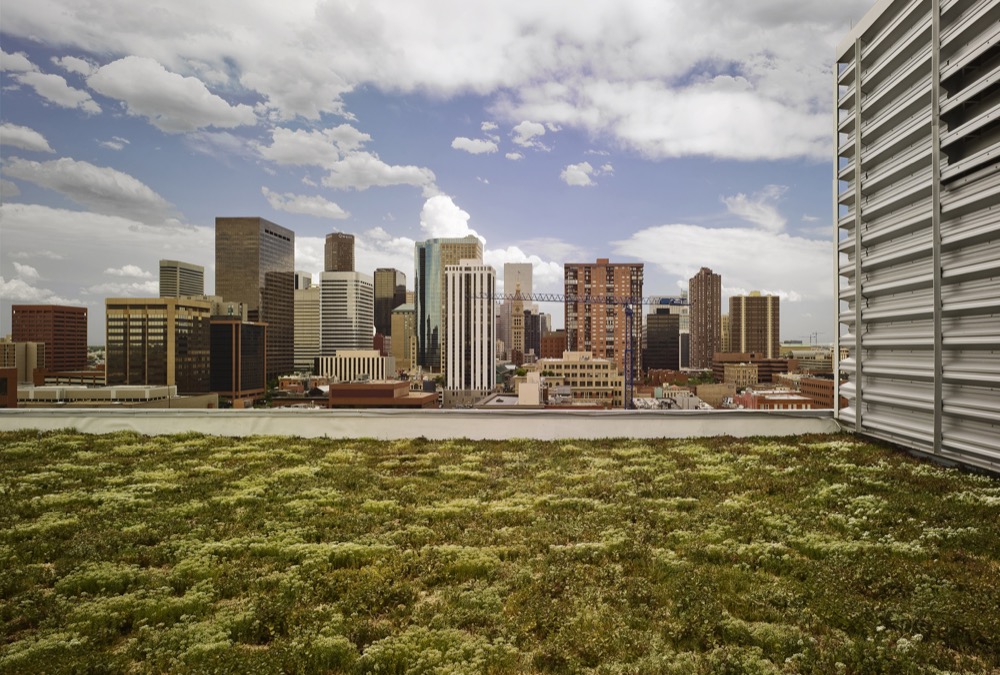An initiative that would require many buildings in Denver to feature environment-friendly “green roof” amenities, that will appear on the city’s ballot this November, has met strong opposition from the commercial real estate industry, concerned about the negative impact the proposed ordinance could have on Denver.
The ordinance would require all new commercial buildings over 25,000-square-feet and all existing commercial buildings over 25,000-square-feet that replace a roof, to have at least 20 percent green space or solar panels. The larger the building, the greater the percentage — all the way up to 60 percent for buildings 200,000-square-feet and larger.
A group called the Denver Green Roof Initiative, led by Brandon Rietheimer, started the initiative — modeled after a similar requirement in Toronto that’s been in place since 2010 —with hopes of making an environmental impact on a local level, solving Denver’s growing problems with solar and green roofs across the city.
“City planning didn’t want to visit any of the ideas that we were talking about because they had already updated the building code and so that’s what led us to the citizen initiative,” says Rietheimer.
Denver currently ranks third highest in the United States for Urban Heat Island — a term that describes an urban or metropolitan area that is significantly warmer than its surrounding rural areas due to human activities. By adding green space at roof level, plants and growing media absorb the sun’s rays, helping to keep the building cool by as much as 70 percent to 90 percent in the summer and 10 percent to 30 percent in the winter. Lowering the city’s Urban Heat Island effect would promote cooler days and less energy consumption throughout every building in Denver. Other benefits include but are not limited to increased stormwater management, and improved air quality — a 2020 Sustainability Goal for the city.
According to the Green Roof Initiative, green space at roof level can help filter air and trap dust and other particles much better than a traditional roof. A claim that Katie Kruger, CEO of Denver Metro Commercial Association of Realtors (DMCAR) disputes, “Denver has a very dry and windy climate and the rooftop gardens bring about a significant concern for adding particles and debris to the air, increasing the brown cloud issues.”
DMCAR is leading a coalition of like-entities in firm opposition of the proposed ordinance who find it to be a top-down mandate being presented at a time when Denver is already ahead of the game and pushing forward with an intensive set of green initiatives.
“Citizens for a Responsible Denver was formed to defeat I-300 this November. The measure is an unnecessary and costly mandate for Denver and will have lasting, devastating impacts on the city. Our coalition is formed to educate Denver residents on the negative impacts this measure would have on rental prices, construction costs, and the regulatory burdens the initiative would bring,” says Mark Truax, campaign manager for the coalition.
By far the biggest reason for the opposition is the financial burden that reaches fay beyond the upfront cost to the developer. “The proposed ordinance would exacerbate the affordable housing situation in Denver, driving up rent rates for our residents and pushing small businesses out of the city,” says Kruger.
 Kathie Barstnar, executive director of NAIOP Colorado Chapter — who is supporting DMCAR in their efforts – understands that energy use and finding ways to address the heat island effect are important issues. NAIOP works actively with the city, participating in the Energize Denver project, as well as the Mayors 80×50 Program. “We just don’t feel like a mandated green roof policy in the City and County of Denver is a wise use of our resources in this effort,” says Barstnar.
Kathie Barstnar, executive director of NAIOP Colorado Chapter — who is supporting DMCAR in their efforts – understands that energy use and finding ways to address the heat island effect are important issues. NAIOP works actively with the city, participating in the Energize Denver project, as well as the Mayors 80×50 Program. “We just don’t feel like a mandated green roof policy in the City and County of Denver is a wise use of our resources in this effort,” says Barstnar.
“The proposal seems to have been created in a silo, without respect for the extensive processes that were participated in by the community regarding the many green and environmentally conscious initiatives set forth through the City’s Energize Denver and Denver’s 80×50 plan,” says Kruger.
Another dispute the coalition has with a green roof mandate is its impact on water conservation. In Colorado, which has a semi-arid climate, water is a precious resource. Denver residents are in fact encouraged and incentivized to turn their lawns into zero-scaping to conserve water.
“In other cities such as Seattle, San Francisco, Toronto — their climates are much different than ours. They get far more rain, and they are far more humid, so it’s easier to establish and maintain green roofs, without having to use supplemental water to do that,” says Barstnar.
Conversely, Rietheimer does not think the increase in water use is a valid concern, “These are light-weight systems, using drought tolerant plants. The Environmental Protection Agency headquarters’ 20,000-square-foot green roof — which is a massive green roof — consumes only about the same as a family of four in a year’s time,” he says. “Buildings that are concerned about water conservation can install solar instead.” But DMCAR is particularly concerned about how the cost of solar will impact small businesses in Denver. “The increased expense of a solar roof will be hard for small businesses to come up with. The requirement will make it difficult for owners to continue to choose Denver and for Denver to retain the vibrant mix of small local shops,” says Kruger.
There are also concerns that structurally, many of Denver’s buildings simply will not be able to contend with the new load requirement. By comparison, Denver Mayor Michael B. Hancock’s 80×50 Program — which has the goal of reducing community Greenhouse Gas (GHG) emissions 80 percent below 2005 levels by the year 2050 — requires commercial buildings to include solar in phase two of development. “Because it’s in phase two, it allows us to build structurally to be able to handle the additional weight load for both solar or green roof,” explains Barstnar.
Green-roofs are certainly nothing new in Denver — they were included in the city’s construction of the Environmental Protection Agency headquarters, the Clyfford Still Museum, the Denver Justice Center and the Denver Botanic Gardens — but this is not a one size fits all proposition and without the support of the commercial real estate industry, it will be interesting to see if such a mandate is approved. The city will have to wait until Nov.7, when the Citizen-led I-300 Denver Green Roof Initiative goes to ballot.
By Katie Rapone, editor of Mile High CRE.
Featured image of EPA Denver, courtesy of the Denver Green Roof Initiative.









